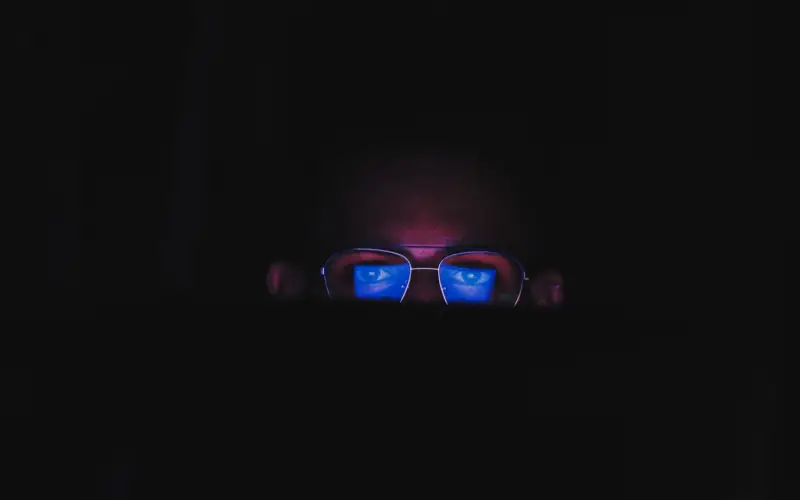Do your eyes ever feel tired or unusually dry after you’ve spent a long time looking at a screen? Or, perhaps you find it difficult to fall asleep after watching TV late into the night? If you’ve answered ‘yes’ to either of these questions, chances are that you’ve been experiencing the effects of blue light on your eyes and sleep patterns.
Blue light, a type of visible light with short wavelengths and high energy, isn’t exclusive to sunlight. Surprisingly, it’s also emitted by artificial sources we interact with daily, such as LED TVs, computer monitors, smartphones, and tablets. Blue light has its positives – it can enhance your mood and make you more alert. However, it does have a downside. This post aims to dissect how blue light impacts our eyes and sleep and how we can utilize technology to mitigate its potential harmful effects.
The Influence of Blue Light on Your Eyes and Vision
Digital eye strain is a prevalent outcome of prolonged exposure to blue light. This condition arises when we spend excessive amounts of time using digital devices without taking sufficient breaks. The symptoms can include dry eyes, blurred vision, and headaches, and can even extend to neck and shoulder pain.
Digital eye strain not only causes immediate discomfort but can also increase the risk of developing other serious eye conditions such as age-related macular degeneration (AMD), cataracts, eye cancer, and growths on the eye’s surface. AMD is common among individuals over 50 and occurs when the macula, the central part of the retina, gets damaged by factors including blue light exposure. Cataracts, on the other hand, are cloudy areas that develop in the eye lens, obstructing vision and often requiring surgical removal. Eye cancer and eye surface growths are rare but serious conditions that can impact the eye and its surrounding tissues. Children are particularly susceptible to these effects, as their eyes absorb more blue light from digital devices.
Blue Light’s Effect on Your Sleep and Circadian Rhythm
Another significant area of our health that blue light influences is our sleep and circadian rhythm. The circadian rhythm is our body’s natural 24-hour clock that regulates a host of physiological processes, including our sleep-wake cycle, hormone production, body temperature, and metabolism. Exposure to blue light during the day can be beneficial, helping us stay alert and synchronized with our environment.
However, blue light exposure at night is a different ball game. It can interfere with our circadian rhythm, suppress melatonin (the hormone that aids in sleep), and delay our sleep cycle. Research has shown that using digital devices before bedtime can delay the onset of sleep, reduce sleep quality and duration, and impact the ability to wake up feeling refreshed. Over time, poor sleep quality can lead to serious health issues such as diabetes, cardiovascular disease, obesity, depression, and cognitive impairment.
Technology to the Rescue: Reducing Blue Light Exposure
Despite the potential negative effects, the good news is that we can use technology to our advantage to lessen blue light’s impact. ‘Seeing is Believing’ and other resources offer valuable insights into how technology can protect our eyesight. Certain devices come with blue light filters or settings that can block or reduce the blue light emitted by the screen. For instance, many smartphones and tablets have a ‘night’ or ‘dark’ mode that automatically adjusts the color and brightness of the screen according to the time of day.
Another worthwhile option is blue light glasses or lenses. These can filter out blue light, helping to prevent eye strain and improve sleep quality. These glasses can be customized to fit your prescription and preferences.
Of course, one of the most straightforward solutions is to limit screen time before bed. By avoiding digital devices at least an hour before you hit the hay, you help your body produce enough melatonin, setting the stage for a restful night’s sleep.
While technology offers solutions, other relaxation methods also exist that can help you unwind effectively. Reading a physical book under warm light, listening to soothing music, meditating, or doing some gentle stretches can all aid in preparing your mind and body for a good night’s sleep.
To wrap it up, it’s essential to remember that blue light isn’t inherently harmful. Like many things in life, it’s about balance. On one hand, blue light can keep us alert and energized during the day, enhancing our mood and productivity. On the other hand, excessive exposure, especially at night, can cause problems for our eyes and disrupt our sleep.
Therefore, it’s vital to be aware of the sources of blue light and understand its potential effects. Using technology in a balanced and responsible way can go a long way in mitigating the potential downsides of blue light exposure. By using blue light filters, wearing protective glasses, adjusting device settings, and controlling our screen time, especially before bed, we can protect our eyes and ensure better sleep quality in this digital age.








